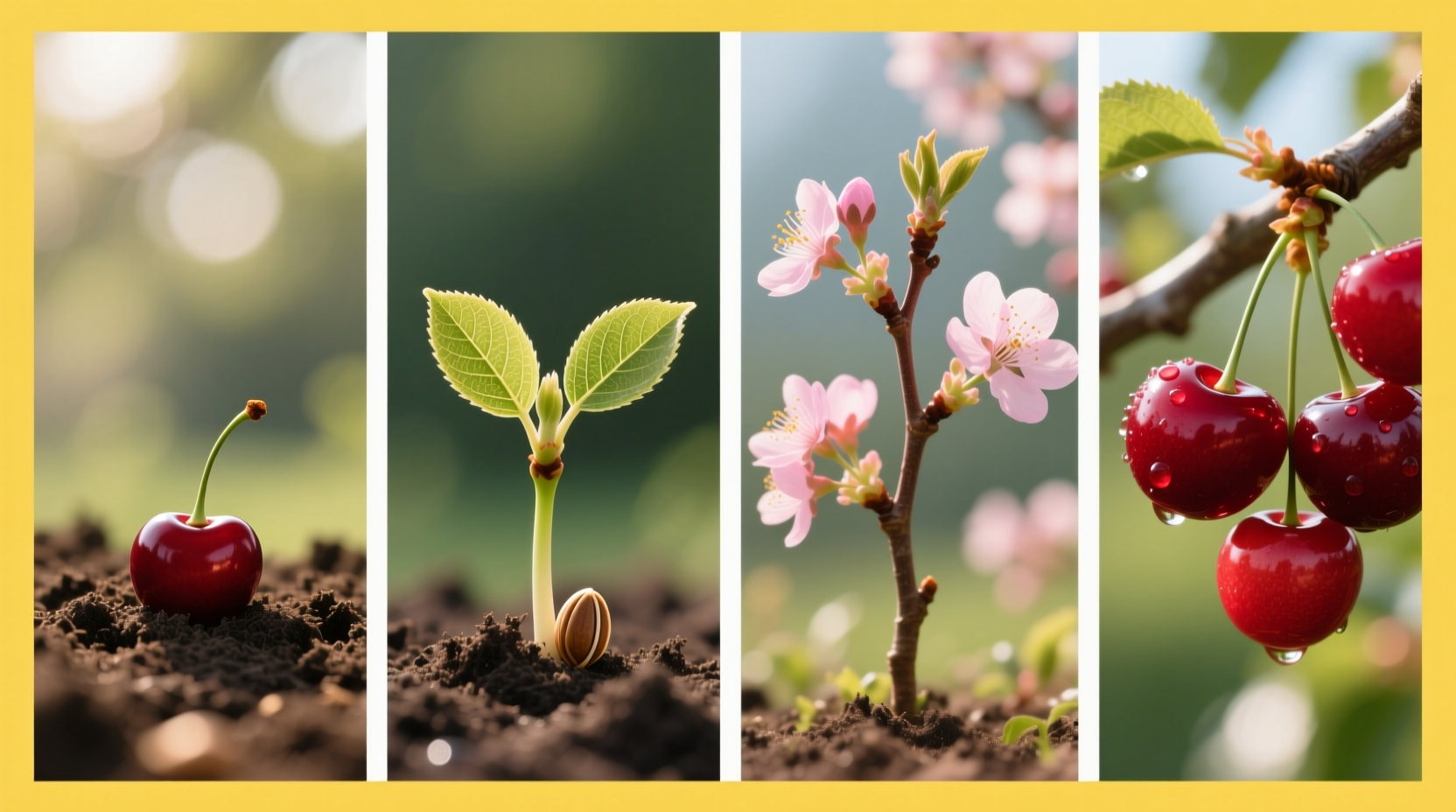Have you ever wondered how long it takes for a cherry tree to go from a tiny seed to bearing those sweet, juicy fruits? If you're planting cherry pits from your favorite snack, you'll need patience—real patience. Understanding the complete growth cycle helps set realistic expectations and improves your chances of success.
The Seed Reality Check: Why Most Cherry Trees Don't Come From Seeds
While planting cherry seeds seems straightforward, commercial growers rarely use this method. When you plant a cherry seed, the resulting tree won't produce fruit identical to its parent due to genetic variation. This biological phenomenon means your Bing cherry seed might yield a completely different variety with inferior fruit quality.
According to the USDA Agricultural Research Service, over 95% of commercial cherry production uses grafted trees rather than seed-grown ones. Grafting combines a desirable fruiting variety with a hardy rootstock, ensuring consistent fruit quality while reducing time to harvest. Seed-grown trees also face higher disease susceptibility during early development stages.
Cherry Growth Timeline: What to Expect Year by Year
Understanding the precise timeline helps manage expectations. Here's what happens at each stage when growing cherries from seed:
| Year | Height | Key Development | Visual Indicators |
|---|---|---|---|
| Year 1 | 6-12 inches | Root establishment | Single stem, few leaves |
| Year 2 | 1-3 feet | Branch framework | Multiple branches, thicker trunk |
| Year 3 | 3-6 feet | Canopy development | Dense foliage, possible flower buds |
| Years 4-5 | 6-12 feet | Pre-fruiting stage | Flowers but no fruit or small fruit |
| Years 5-7 | 12-25 feet | First harvest | Full-size fruit production |
This timeline comes from data collected by Cornell University's horticulture department across multiple cherry varieties. Sweet cherries generally take longer to fruit than sour varieties, with some late-blooming cultivars requiring up to 8 years.
The Science Behind Cherry Tree Development
Cherry trees undergo specific biological processes at each growth stage. During the first year, energy focuses on root development rather than visible growth. The University of Minnesota Extension explains that cherry seeds require 90-140 days of cold stratification to break dormancy—a process mimicking winter conditions that triggers germination.
From years 2-4, the tree develops its vascular system and establishes carbohydrate reserves. This critical phase determines future fruit production capacity. Without proper nutrition and pruning during this period, trees may never reach full productivity.

Factors That Determine Your Cherry Tree's Success
Several environmental factors significantly impact growth speed and fruit quality:
- Climate requirements: Most cherry varieties need 700-1,200 chilling hours below 45°F (7°C) annually
- Soil conditions: Well-drained loam with pH between 6.0-7.0 performs best
- Water needs: Consistent moisture during fruit development prevents cracking
- Pollination: Sweet cherries require cross-pollination from compatible varieties
The USDA Plant Hardiness Zone Map shows that sweet cherries grow best in zones 5-8, while sour cherries tolerate zones 4-9. Attempting to grow cherries outside these zones dramatically increases the time to fruiting and reduces yield.
Practical Guide: Growing Cherry Trees From Seed Successfully
If you're determined to grow cherries from seed, follow these science-backed steps:
- Extract seeds from fully ripe cherries and clean thoroughly
- Stratify seeds in moist peat moss in refrigerator for 90-140 days
- Plant seeds 1 inch deep in well-draining potting mix
- Maintain consistent moisture (not soggy) during germination
- Transplant seedlings to permanent location after first year
- Apply balanced fertilizer during active growth periods
- Prune to establish strong branch structure during years 2-4
Even with perfect care, expect only a 30-40% success rate with seed-grown cherry trees reaching fruiting stage. The University of California's pomology department recommends grafting desirable varieties onto established rootstocks after 2-3 years to accelerate fruit production.
When to Consider Alternative Approaches
For home growers wanting faster results, consider these alternatives:
- Purchase 1-2 year old grafted trees (produces fruit in 2-4 years)
- Use air layering on existing cherry trees
- Try dwarf varieties that fruit earlier (3-5 years)
Remember that patience pays off—properly cared for cherry trees can produce fruit for 20-30 years once established. The wait for that first homegrown cherry harvest makes the long journey from seed to fruit worthwhile.
Frequently Asked Questions
How long does it take for cherry seeds to germinate?
Cherry seeds typically take 2-8 weeks to germinate after completing cold stratification. The germination process requires consistent moisture and temperatures between 60-70°F (15-21°C). Without proper stratification, germination may not occur at all.
Can I grow a cherry tree indoors from seed?
While possible to start cherry seeds indoors, they require outdoor conditions for proper development. Cherry trees need seasonal temperature changes and sufficient sunlight that indoor environments cannot provide long-term. After germination, seedlings should be moved outdoors within 6-8 weeks.
Why do seed-grown cherry trees take longer to fruit than grafted trees?
Seed-grown trees must complete their full juvenile phase before becoming reproductive, which takes 5-7 years. Grafted trees use mature scion wood that has already passed this phase, allowing them to focus energy on fruit production rather than developmental stages.
What's the success rate for growing cherry trees from seed?
The success rate for growing productive cherry trees from seed ranges from 30-40%. Many seedlings fail to reach maturity due to disease susceptibility, environmental stress, or genetic factors that prevent proper fruit development.











 浙公网安备
33010002000092号
浙公网安备
33010002000092号 浙B2-20120091-4
浙B2-20120091-4